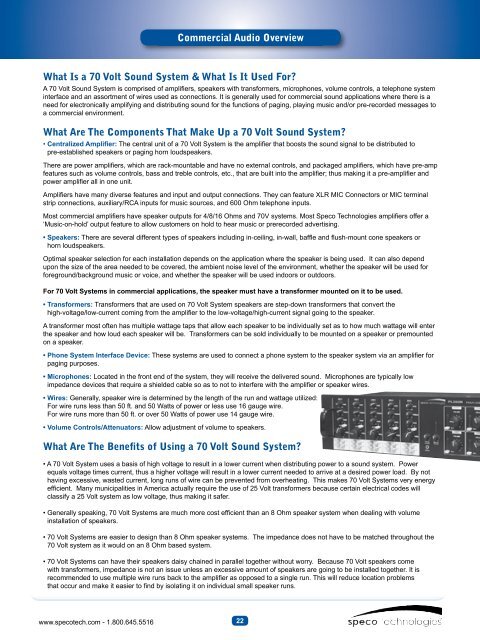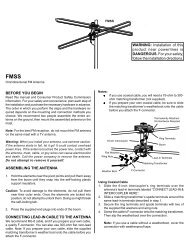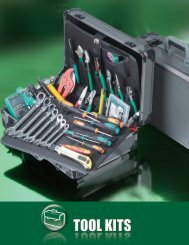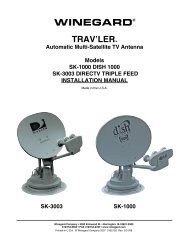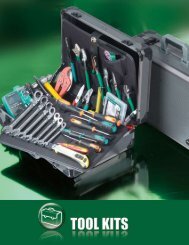Download Audio Catalog - Speco Technologies
Download Audio Catalog - Speco Technologies
Download Audio Catalog - Speco Technologies
Create successful ePaper yourself
Turn your PDF publications into a flip-book with our unique Google optimized e-Paper software.
Commercial <strong>Audio</strong> Overview<br />
Commercial <strong>Audio</strong> Overview<br />
What Is a 70 Volt Sound System & What Is It Used For?<br />
A 70 Volt Sound System is comprised of amplifiers, speakers with transformers, microphones, volume controls, a telephone system<br />
interface and an assortment of wires used as connections. It is generally used for commercial sound applications where there is a<br />
need for electronically amplifying and distributing sound for the functions of paging, playing music and/or pre-recorded messages to<br />
a commercial environment.<br />
What Are The Components That Make Up a 70 Volt Sound System?<br />
• Centralized Amplifier: The central unit of a 70 Volt System is the amplifier that boosts the sound signal to be distributed to<br />
pre-established speakers or paging horn loudspeakers.<br />
There are power amplifiers, which are rack-mountable and have no external controls, and packaged amplifiers, which have pre-amp<br />
features such as volume controls, bass and treble controls, etc., that are built into the amplifier; thus making it a pre-amplifier and<br />
power amplifier all in one unit.<br />
Amplifiers have many diverse features and input and output connections. They can feature XLR MIC Connectors or MIC terminal<br />
strip connections, auxiliary/RCA inputs for music sources, and 600 Ohm telephone inputs.<br />
Most commercial amplifiers have speaker outputs for 4/8/16 Ohms and 70V systems. Most <strong>Speco</strong> <strong>Technologies</strong> amplifiers offer a<br />
‘Music-on-hold’ output feature to allow customers on hold to hear music or prerecorded advertising.<br />
• Speakers: There are several different types of speakers including in-ceiling, in-wall, baffle and flush-mount cone speakers or<br />
horn loudspeakers.<br />
Optimal speaker selection for each installation depends on the application where the speaker is being used. It can also depend<br />
upon the size of the area needed to be covered, the ambient noise level of the environment, whether the speaker will be used for<br />
foreground/background music or voice, and whether the speaker will be used indoors or outdoors.<br />
For 70 Volt Systems in commercial applications, the speaker must have a transformer mounted on it to be used.<br />
• Transformers: Transformers that are used on 70 Volt System speakers are step-down transformers that convert the<br />
high-voltage/low-current coming from the amplifier to the low-voltage/high-current signal going to the speaker.<br />
A transformer most often has multiple wattage taps that allow each speaker to be individually set as to how much wattage will enter<br />
the speaker and how loud each speaker will be. Transformers can be sold individually to be mounted on a speaker or premounted<br />
on a speaker.<br />
• Phone System Interface Device: These systems are used to connect a phone system to the speaker system via an amplifier for<br />
paging purposes.<br />
• Microphones: Located in the front end of the system, they will receive the delivered sound. Microphones are typically low<br />
impedance devices that require a shielded cable so as to not to interfere with the amplifier or speaker wires.<br />
• Wires: Generally, speaker wire is determined by the length of the run and wattage utilized:<br />
For wire runs less than 50 ft. and 50 Watts of power or less use 16 gauge wire.<br />
For wire runs more than 50 ft. or over 50 Watts of power use 14 gauge wire.<br />
• Volume Controls/Attenuators: Allow adjustment of volume to speakers.<br />
What Are The Benefits of Using a 70 Volt Sound System?<br />
• A 70 Volt System uses a basis of high voltage to result in a lower current when distributing power to a sound system. Power<br />
equals voltage times current, thus a higher voltage will result in a lower current needed to arrive at a desired power load. By not<br />
having excessive, wasted current, long runs of wire can be prevented from overheating. This makes 70 Volt Systems very energy<br />
efficient. Many municipalities in America actually require the use of 25 Volt transformers because certain electrical codes will<br />
classify a 25 Volt system as low voltage, thus making it safer.<br />
• Generally speaking, 70 Volt Systems are much more cost efficient than an 8 Ohm speaker system when dealing with volume<br />
installation of speakers.<br />
• 70 Volt Systems are easier to design than 8 Ohm speaker systems. The impedance does not have to be matched throughout the<br />
70 Volt system as it would on an 8 Ohm based system.<br />
• 70 Volt Systems can have their speakers daisy chained in parallel together without worry. Because 70 Volt speakers come<br />
with transformers, impedance is not an issue unless an excessive amount of speakers are going to be installed together. It is<br />
recommended to use multiple wire runs back to the amplifier as opposed to a single run. This will reduce location problems<br />
that occur and make it easier to find by isolating it on individual small speaker runs.<br />
What Are The Benefits of Using a 70 Volt Sound System? (cont’d)<br />
• An easy calculation is all that is needed in determining the amount of wattage needed by your amplifier. Take the total wattage<br />
requirement of the 70 Volt speakers, or “load”, include a 20% safety buffer to the upside and you will obtain the minimum RMS<br />
wattage.<br />
• 70 Volt Systems allow the volume of each individual speaker in a specific area to be set using wattage taps. The higher the<br />
wattage taps are set on individual speakers, the more power the speaker consumes, the louder the speaker will be.<br />
• The speaker transformer serves as a safeguard to make sure individual speakers are not damaged by excessive wattage.<br />
Designing a 70 Volt System:<br />
Which Type of 70V Speaker Should I Use?<br />
In-Ceiling Speakers – Best utilized in 8, 10 & 12 ft. drop ceilings in professional environments with low noise levels.<br />
Great for background music and/or paging. Ceiling support brackets should be used with in-ceiling speakers.<br />
Wall Baffle or Wall Mount Speakers – Best utilized when the ceiling’s height is prohibitive to speaker placement and/or speakers<br />
can not be mounted on the ceiling at all.<br />
PA Horns – Horns are usually utilized in loud environments when distinct, and powerful paging messages are needed or when<br />
large areas must be covered. In addition, most PA Horns are weatherproof and are used for outdoor applications such as loading<br />
docks and sports fields.<br />
How Many Speakers Should I Use?<br />
Determining Proper Use Quantity For In-Ceiling Speakers:<br />
The industry standard for calculating the proper amount of in-ceiling speakers for a specific area is to should have twice the space<br />
from the floor to the ceiling between the placement of each speaker on the ceiling, as shown in Diagram 1:<br />
Diagram 1: Speaker Spacing on Ceilings<br />
Ceiling Speakers Should be Spaced Apart at Twice the Space of the Ceiling Height<br />
◀<br />
8 ft.<br />
▶<br />
◀<br />
Ceiling - 16 ft.<br />
Speaker 1 Speaker 2<br />
Floor<br />
For example, if your installation involves an 8 foot ceiling, then the speakers should be placed 16 feet apart on a square footage<br />
basis which equals 256 ft. of ceiling area covered. The following square area coverage chart shows specific ceiling heights:<br />
Speaker Square Footage Coverage for Ceiling Heights<br />
Height of Ceiling<br />
Spacing of Speakers<br />
(ceiling height x2)<br />
8 foot ceiling 8 ft. 16 ft. 16 x 16 = 256 ft.<br />
10 foot ceiling 10 ft. 20 ft. 20 x 20 = 400 ft.<br />
12 foot ceiling 12 ft. 24 ft. 24 x 24 = 576 ft.<br />
As you will notice, lowering the ceiling height results in the less square footage coverage per speaker, or the more speakers you<br />
will need. This is due to there is less downward space for sound dispersion before it reaches the listener.<br />
On the following page there is an easy reference chart for determining the correct number of speakers needed for a specific area<br />
to assure proper dispersion of sound.<br />
▶<br />
Square feet coverage<br />
per Speaker<br />
22 23<br />
www.specotech.com - 1.800.645.5516 www.specotech.com - 1.800.645.5516


